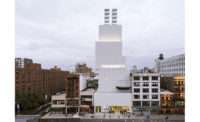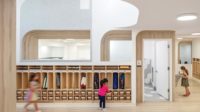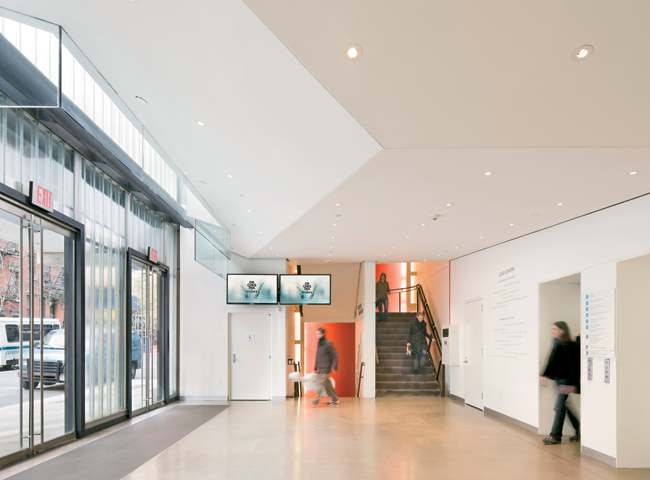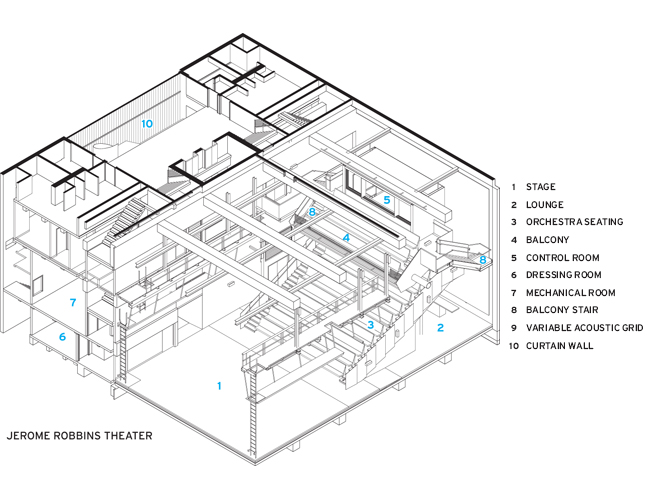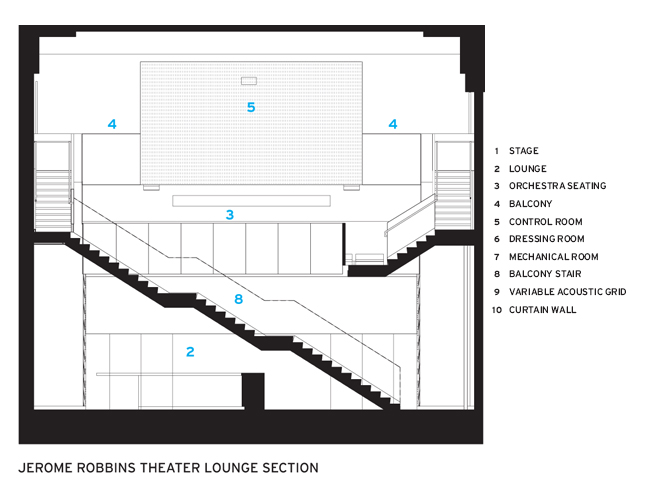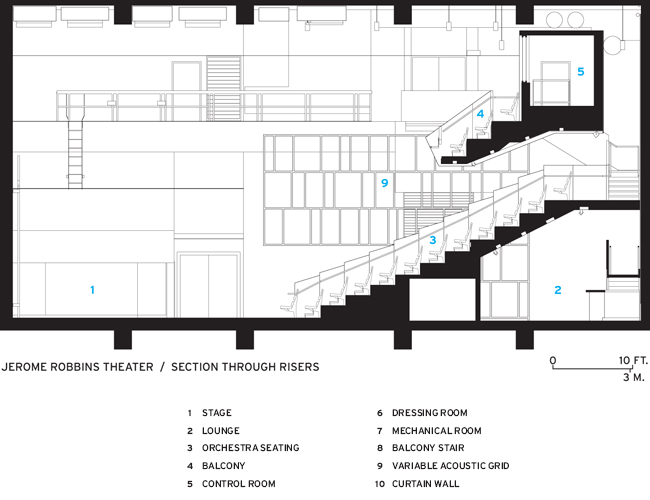450 West 37th Street in New York City
WASA/Studio A and H3 Hardy Collaboration Architecture

The DiMenna Center for Classical Music: H3 Hardy Collaboration Architecture

























In the high-stakes real-estate environment of New York City every square foot counts — especially for space- and cash-starved arts organizations. So when Mikhail Baryshnikov, artistic director of the Baryshnikov Arts Center (BAC), teamed with a consortium of off-Broadway theater producers to build a new 46,000-square-foot building at 450 West Thirty-seventh Street in Manhattan’s Hell’s Kitchen neighborhood, expectations were high. Indeed, the six-story, concrete-and-glass structure was designed by the late architect John Averitt (who died a year before its completion) to be a versatile, column-free performing-arts hub. When it opened in 2005, a trio of stacked, “for-rent” theaters operated by the producers occupied the three lower levels. Baryshnikov built out the upper floors for the offices and studios of the nonprofit BAC. But, while the theaters were outfitted with stages and seating, they were left spare for visiting companies to equip as needed, and ultimately lacked the necessary acoustics and theatrical gear to make them marketable. Long story short, the theaters were sold after three years. BAC purchased one, and Orchestra of St. Luke’s, another nonprofit, bought the other two — each owner with its own plans to tap the city’s top theatrical consultants and architects for extensive renovations.
JEROME ROBBINS THEATRE
The rapid demise of the original theaters turned out to be a blessing for the Baryshnikov Arts Center (BAC). Established as a creative laboratory and performance space, the center comprised four daylight-filled dance studios, a studio theater, and offices when it opened in 2005. By purchasing the 5,200-square-foot theater beneath it, BAC acquired a 42-by-72-by-36-foot box that would provide an ideal volume within which to create a state-of-the-art venue for more fully realized dance, music, and theater events. The potential to boost its programming and revenue stream was strong, but first the space had to be gutted.
“They basically hated everything except the four walls,” recalls architect Martin Kapell, WASA/Studio A design partner-in-charge of the project. “They liked the shape, proportion, and materiality of the room, which is all-concrete. But everything inside it was either wrong or insufficient.” Sight lines, egress, seat alignment, lighting, sound, and noise all had to be addressed. Plus, he adds, “They wanted a more complete technical theater.”
Having worked as a stage manager prior to becoming an architect, Kapell understood that the job’s primary focus was to support the experience and relationship of the performer and audience. With this in mind, he and his associates collaborated closely with other members of the design and construction team, in particular the theater consultants and acoustician from Arup, to develop a scheme that would integrate the high-performance specifications the client was after.
The new theater is a textural juxtaposition of refined and rough surfaces in which the architects exposed the concrete walls and mechanicals, painting them a warm black-brown to make them “disappear.” Kapell wanted to express the full potential, and rawness, of the space. So the crew stripped the room, then isolated the box from external noise and rumblings by segregating the plant, silencing ductwork, and underpinning a resilient sprung floor with a floating reinforced-concrete slab 4 inches above the existing slab.
According to acoustician Rachid Abu-Hassan, the building’s dense concrete walls are good sound insulators. However, as the dense concrete is also highly reflective, introducing soft, absorbing finishes was required. To achieve the flawless acoustics desired, he installed perforated, sound-absorbing wood-veneer panels on the back wall, and bass absorbing insulation along the uppermost section of the longitudinal walls. For additional reverberation control in the event of amplified sound, the acousticians applied large steel grids that receive modular sound-absorbing panels along the same walls, and hung movable velour drapes on either side of the stage.
The heart of the project is Kapell’s stadium seating, an ingenious structure centered in the space so that the lobby lounge could be tucked behind it. Framed in thin, pre-finished Corten steel and fitted with 238 plush, bench-style seats, it is configured to bolster sound quality and sight lines, improve circulation, and accommodate stage lighting and a balcony control room.
“The idea was to maximize the size of the room,” admits Kapell. But then, he says, “The thing I find most satisfying and aesthetically pleasing about the project results from solving technical issues.”
THE DIMENNA CENTER FOR CLASSICAL MUSIC
Orchestra of St. Luke’s (OSL) had been searching for a home, the first in its 37-year history, when cofounder Marianne Lockwood learned that Baryshnikov was looking for a like-minded partner to share his building. In November 2008, after years of strategic analysis, OSL bought the lower 20,000-square-foot space that included the two theaters — sealing the deal at a dual closing with BAC.
OSL retained H3 Hardy Collaboration Architecture and the acousticians at Akustiks to transform the two large volumes into topflight rehearsal and recording studios, for its own needs, as well as for rental by local and touring ensembles. And because the musicians spend so much time rehearsing, says project architect Geoff Lynch, OSL’s brief stipulated warm, homey environments with concert-hall-quality lighting and no rough concrete in view.
After demolishing the existing theaters, the two firms worked in tandem to realize the project’s acoustic objectives: to isolate the stacked rooms from street noise, the building’s mechanical system vibrations, and each other, as well as the Jerome Robbins Theater above; then to replicate the aural experience of the concert halls in which the musicians perform.
Implementing box-in-a-box construction, the H3 and Akustiks teams separated the two main halls with floating concrete-slab floors on neoprene pads and springs, and fiberglass-packed concrete-block or gypsum sound-control walls and ceilings within the existing structural envelope. The architects divided the remaining space into a recording/media studio and small practice rooms (all isolated to a lesser degree), plus a music library with compact shelving, offices, lounges, a café, and showers.
The 3,395-square-foot Cary Hall, on the lower level, accommodates a full orchestra and chorus, while the 1,649-square-foot Benzaquen Hall above it fits smaller chamber ensembles. From an acoustic point of view, Akustiks principal Russell Todd says, the challenge was that “in small spaces like these, a fraction of the size of Carnegie Hall, the music can sound harsh and too loud, so that the musicians can’t hear themselves or the other sections.” To recreate the dynamics and breadth of an actual performance without overpowering them, he applied a series of acoustic surfaces and interventions to diffuse and balance the sound in varying degrees for each space. Guided by Todd’s rigorous criteria, Lynch and H3 interior designer Margaret Sullivan shaped the spaces and camouflaged the visual cacophony of acoustic paraphernalia with rich, acoustically transparent materials. They added soundproof skylights to the sub-grade Cary Hall and enveloped the room in a modular screen of red oak strips rounded and spaced to Todd’s specifications. Likewise, they wrapped Benzaquen Hall in a stretch scrim, inset with carefully placed red oak ribs. They lined the practice and media rooms with oatmeal- and gray-hued sound-absorbing felt offset by decorative, reflective ribbons of gypsum, positioned to avoid flutter echo.
At an early preview OSL played the overture to Mozart’s The Magic Flute in Cary Hall. The sound was lush and even, the room intimate. “The success of the project is a result of many things coming together,” says Lynch. Along with the BAC, the DiMenna Center illustrates how distinct artistic, administrative, and architectural teams can coalesce to turn a struggling entity into a successful venue through thoughtful planning and reconstruction.
Architect (Jerome Robbins Theater)
WASA/Studio A
740 Broadway
New York, NY 10003
p 212.420.1160
f 212.529.9079
Architect (Dimenna Center for Classical Music)
H3 Hardy Collaboration Architecture
902 Broadway, 19th Floor
New York, New York 10010
t. 212.677.6030
f. 212.979.0535
PeopleJEROME ROBBINS THEATRE Owner: Baryshnikov Arts Center Completion Date: January 2010 Total construction cost: $6 million Architect Personnel in architect's firm who should receive special credit: Engineering Partner-In-Charge: Harry Spring, PE Project Architect: Laura Boynton, LEED AP Engineer(s) Harry Spring, Partner-In-Charge Plumbing: Electrical: Mechanical: Structural Engineer: Consultant(s) David Taylor, Project Director General contractor John Dwyer, Vice President of Operations Bill Conklin, Project Manager Bob Schoendorf, Site Superintendant CAD system, project management, or other software used: Autodesk Revit Architecture, Autodesk Revit Engineering, Autodesk Revit Structural DIMENNA CENTER FOR CLASSICAL MUSIC Owner: Orchestra of St. Luke’s Completion Date: March 2011 Gross square footage: 20,000 sq. ft. Total construction cost: $10 million Architect: Personnel in architect's firm who should receive special credit: Interior designer: H3 – see above. Engineer(s) Consultant(s): Acoustics/AV:Akustiks Theater : Auerbach Pollack Friedlander Photographer(s) CAD system, project management, or other software used: BIM / Revit |
ProductsJEROME ROBBINS THEATRE Structural system Existing building: Windows Doors QuietStar Industries (Manufacturer’s Representative) Hardware Closers: Exit devices: Pulls: Other special hardware: Interior finishes Paints and stains: Acoustic Wall Panels: Special surfacing: Acoustical Wood Veneer Wall Panels: Furnishings Lighting Bruck Lighting Systems (AB2) Delta Light Kurt Versen Company Linear Lighting Corp. Winona Lighting Dimming System or other lighting controls: See Spec Energy BAS Control Panels (HVAC): Sensors (HVAC) Lighting controls: Other unique products that contribute to sustainability: QuietRock Soundproof drywall: DIMENNA CENTER FOR CLASSICAL MUSIC Structural system Exterior cladding Glazing Skylights: Wasco Classic Series (skylight in Cary Hall) Insulated-panel or plastic glazing: N/A – adaptive reuse project Other: Dorma Storefront in lobby for production offices Doors Metal doors: Long Island Fireproof Door (Rooftop access) Special doors: Acoustic doors: Overly Door Company Hardware Closers: Stanley Exit devices: Precision Pulls: Mockett, Rockwood Security devices: ADT Other special hardware: Dorma (storefront system), Precision, Rockwood (stops) Interior finishes Suspension grid: USG with hangers from Vibration Products and Kinetics Demountable partitions: Hadrian Elite Ceiling Mounted Stainless Steel Toilet Partitions Cabinetwork and custom woodwork: Custom red oak wood slats (Cary and Benzaquen Halls) and custom red oak bar (café) Paints and stains: Benjamin Moore Wall coverings: Weitzner Aura (Green Room), Innovations Pearl (Practice Rooms), Sutherland Industrial Felt (Green Room, Media Studio, and Practice Rooms) Paneling: Steeletex Custom Stretch Fabric (Benzaquen Hall, with Red Oak Slats) Plastic laminate: Formica (Work surfaces) Solid surfacing: Corian (restrooms) Floor and wall tile: Daltile (Shower area flooring and walls) Resilient flooring: Forbo Marmoleum (IT Room) Carpet: Bentley Prince Street Pure Element & Bare Earth (offices) Wood Flooring: Custom red oak Furnishings Chairs: Tom Dixon Slab Chairs, Moroso YY Chairs, and Bo Concept Couches (Lounges), Arper Stacking Chairs (Learning and Media Studio) Tables: 5 Star custom coffee and side tables (Lounge) Upholstery: Carnegie Gem (Café bench upholstery) Custom Café Bar: Skyline Glass EcoTech (glass divider), Stainless Steel (worksurface top) Lighting Downlights: In Cary, Benzaquen, and lobbies: Kurt Versen, Zumtobel, Litelab, Se’Lux, Insight; in lobby: Lucifer; exit signs: Lithonia; Bega. Task lighting: Conran Mini-Z LED Desk Lamp (office task lighting) Exterior: Ereo (spot light down onto skylights) Dimming System or other lighting controls: Lutron Graphik Eye, Luxtrol Light Control Dimmer, Strand Lighting Occupancy Sensors, Lutron Occupancy Sensors, Barbizon Plumbing Grohe Minta Faucet (café) Other unique products that contribute to sustainability: |



